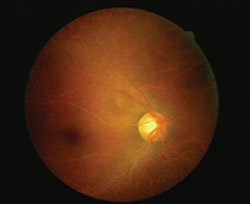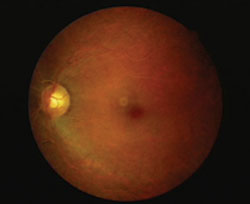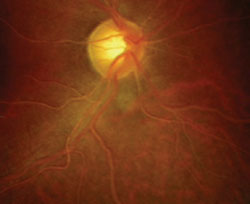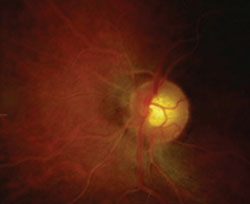Milky white retinal vessels seen during routine exam
The patient had recently been diagnosed with colon cancer and had type 2 diabetes mellitus, hypertension and angina pectoras.
 James F. Hill III |
A 53-year-old black man came to the optometry clinic as a consult for his annual exam from the primary care clinic. He reported no complaints about his vision or eye health and said he was feeling well the day of the exam.
The patient had recently been diagnosed with colon cancer. Seven months prior to the exam he had surgery to remove an adenocarcinoma of the colon and had been treated with intravenous and oral chemotherapy for 5 months. At the time of the eye exam, the chemotherapy had been discontinued and he was to be reassessed by his oncologist in 3 months. His medical history was also significant for type 2 diabetes mellitus, hypertension and angina pectoras.
His current medications included Novolin 70/30 Innolet (70% NPH, human insulin isophane suspension and 30% regular, human insulin injection [recombinant DNA origin], Novo Nordisk) 10 units twice daily, amlodipine 5 mg twice daily, atenolol 100 mg once daily, lisinopril 40 mg once daily, isosorbide dinitrate 20 mg divided in two doses daily, heparin 10 units/mL in a 5 mL flush as needed and simvastatin 40 mg daily. His previous chemotherapy drugs included intravenous fluorouracil, oxaliplatin, ondansetron and leucovorin calcium, as well as oral administration of capecitabine 500 mg four times a day for 2 weeks and discontinue for 1 week in 3-week cycles.
|
|
|
|
Posterior pole of the right and left eyes.
Images: Hill JF |
|
|
|
|
|
Optic nerve, arteries and veins of the right
and left eyes. |
|
The patient’s best-corrected acuity was 20/20 in the right and left eye. Pupils were equal at 4 mm and reactive to light with no signs of an afferent pupillary defect. Extraocular muscle movements were full and smooth in each eye. Lids, lashes, sclera and conjunctiva were unremarkable in each eye.
The cornea had trace superficial punctate keratitis inferiorly in each eye. The iris was flat and unremarkable in each eye with no signs of neovascularization. The anterior chamber was deep and quiet in each eye and IOPs measured 15 mm Hg OD and 16 mm Hg OS at 3:30 p.m. The patient was phakic, and both the right and left lenses were clear with no signs of opacity.
Dilated fundus exam showed that the vitreous was clear in both eyes. Subjective cup-to-disc ratio was 0.45 horizontally and 0.45 vertically in each eye. The neuroretinal rim tissue was healthy, the rim was intact, and the optic discs showed no neovascularization. The macula was flat and unremarkable in both eyes with no signs of clinically significant macular edema. The retinal vasculature of both eyes presented as a milky white color, and the retina in general had a salmon-like appearance. The peripheral retina was clear with no conditions predisposing the eye to retinal detachment or neovascularization.
Based on a chart review, the patient had good control of his blood glucose levels and HbA1C until the diagnosis and treatment of colon cancer. A 2-year history previous to treatment showed an average blood glucose level of 106 mg/dL and a 7.0 HbA1C. In addition, the triglyceride level averaged 90 mg/dL and the total cholesterol 145 mg/dL. The most recent lab testing was conducted 3 weeks prior to the eye exam and it showed a blood glucose level of 429 mg/dL, HbA1C of 14.1, triglyceride level of 2,136 mg/dL and total cholesterol level of 234 mg/dL.

What is your diagnosis?
Milky white vessels
Due to extremely high triglyceride levels, the appearance of a milky white retinal arteries and veins, along with a salmon-colored retinal background a diagnosis of lipemia retinalis (LR) was made. LR occurs in the presence of extremely elevated triglyceride levels (usually exceeding 1,000 mg/dL to 2,500 mg/dL).
Clinical picture
The clinical picture as seen in the retina begins initially with changes in the peripheral vessels, where they take on a milky appearance, then the arteries and veins become indistinguishable and are flat and ribbon-like. The appearance spreads centrally, as the blood lipid content rises and reaches 10%. Histologically, the vessels and the perivascular lymph spaces contain a plasma loaded with emulsified fat. No disturbance of retinal function is associated with these changes, nor is there any microscopic evidence that the lipemia damages the retina in any way. LR is seen most frequently in association with diabetes mellitus in patients with acidosis and ketosis.
LR, xanthelasma, corneal arcus, effects of retinal blood flow and lipid emboli are all ophthalmic findings associated with hypertriglyceridemia. Primary hypertriglyceridemia is familial, but secondary hypertriglyceridemia has numerous causes including: diabetes mellitus, hypothyroidism, diet high in saturated fats, renal disease, sarcoidosis, rare metabolic syndromes and some medications such as tamoxifen, capecitabine and 13-cis-retinoic acid.
|
|
|
|
Posterior poles of the right and left eyes at
the patient’s 3-month follow-up. |
|
When hyperlipidemia occurs in a diabetic patient with uncontrolled blood glucose levels, most of the lipid that accumulates in the blood is triglyceride. Increased hepatic synthesis of triglyceride, increased dietary intake of triglyceride and delayed clearance of triglyceride from the blood may all play a part in causing this excessive increase. In uncontrolled diabetes, increased mobilization of free fatty acids from adipose tissue raises the blood level of free fatty acids, and there is considerable evidence that this promotes increased hepatic synthesis of triglyceride. With all insulin-dependent diabetics, a major complication that can manifest is diabetic ketoacidosis.
Major complication of diabetes
Diabetic ketoacidosis results from insulin deficiency in insulin-dependent diabetes mellitus leading to hyperglycemia, hyperketonemia and ensuing osmotic diuresis, dehydration and urinary loss of serum electrolytes, which is life threatening. When the content of neutral triglycerides is raised sufficiently (more than 1,000 mg/dL to 2,500 mg/dL), the serum is milky in appearance. The hypertriglyceridemia of diabetes can be classified into mild to moderate (triglycerides between 150 mg/dL to 499 mg/dL) and severe hypertriglyceridemia (triglycerides at least 500 mg/dL).
Chylomicronemia occurs when plasma triglyceride levels exceed 1,000 mg/dL. Chylomicronemia syndrome is defined when chylomicronemia is accompanied by one or more of the following: LR, eruptive xanthoma or abdominal findings including abdominal pain, acute pancreatitis or hepatosplenomegaly. The major concern with chylomicronemia is the development of acute pancreatitis (swelling and inflammation of the pancreas), which can lead to severe complications and high mortality despite treatment.
Treatment, management
The appearance of milky white retinal vasculature is pathognomonic for LR. It is a direct result of severe hypertriglyceridemia. The patient in our case was made aware of the clinical diagnosis and the possible risk of acute pancreatitis if left untreated. We educated him to make sure he was taking all medications properly and about the importance of a healthy diet.
The patient’s primary care physician was also notified of the finding, and an office visit was scheduled. We scheduled the patient to return to the optometry clinic for a 3-month follow-up to monitor the retinal finding. At the follow-up, all findings were normal, and the LR had resolved.
The primary goal in treating our patient was to maintain fasting triglyceride levels at less than 500 mg/dL to reduce the risk for acute pancreatitis. Hypertriglyceridemia occurring in the setting of diabetes mellitus can be improved with adequate blood sugar control. The primary care physician should be informed, and patient education is crucial for the best outcome.
An important point for all primary eye care physicians is if you identify chylomicronemic patients due to LR with abdominal pain they should be considered to have a medical emergency because of the concern for acute pancreatitis.
References:
- Bar-Sela G, Haim N. Uncontrolled hypertriglyceridemia induced by capecitabine: case report and review of the literature. Cancer Chemother Pharmacol. 2009;63:779–782.
- Jialal I, Amess W, Kaur M. Uncontrolled hypertriglyceridemia induced by capecitabine: case report and review of the literature. Curr Diab Rep. 2010;10(4):316-320.
- Leaf DA. Chylomicronemia and the chylomicronemia syndrome: A practical approach to management. Am J Med. 2008;121:10-12.
- Winder AD, Dodson WM, Galton DJ. Ophthalmological complications of the hypertriglyceridaemias.Trans Ophthalmol Soc UK. 1980;100:119-122.
- James F. Hill III, OD, is in private practice in Lexington, Ky. He can be reached at 701 Henry Clay Blvd., Lexington, KY; (859) 253-0073; hillfamilyeyecare@gmail.com. Dr. Hill has no direct financial interest in the products mentioned in this article, nor is he a paid consultant for any companies mentioned.
- Edited by Leo P. Semes, OD, a professor of optometry, University of Alabama at Birmingham and a member of the Primary Care Optometry News Editorial Board. He may be contacted at 1716 University Blvd., Birmingham, AL 35294-0010; (205) 934-6773; fax: (205) 934-6758; lsemes@uab.edu.







